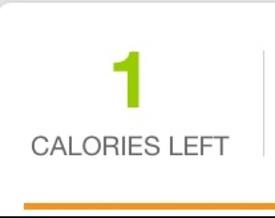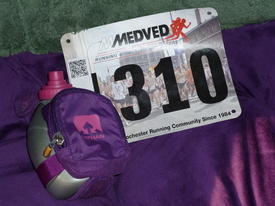Heart Rate Monitor Recommendations

raelynne629
Posts: 24 Member
Anyone have one that they love or hate? I'm probably looking for a fairly inexpensive one...
0
Replies
-
I currently use a Polar FT7 and I love it. My sister and husband use one as well. I did have a Timex one but it was not consistent in monitoring my heart rate. I checked out Heartmonitor.com and was able to get the Polar on sale.0
-
Polar FT7 all the way!!!0
-
Love my Polar FT4 - it is one of the less expensive options that is regarded as being very accurate for calorie burn. The FT7 has more options but the FT4 will get the job done if your only concern is calories.0
-
I just ordered an FT4 and it should be coming this week. I can't wait to try it! It cost me $66 on Amazon.0
-
Got the FT4 for $79 at Sports Authority.. Couldn't wait ... works great.. good choice.0
-
FT4, I have been using it for the past 2 weeks and love it...got mine on Amazon for around $50. Really simple to use, shows calories burned, target zones, etc. Pretty basic. The chest strap is the most comfortable that I have found. Its easy on and off.0
-
I have the Polar FT4. Not a lot of bells and whistles with it but it seems accurate and gets the job done.
My husband has a Polar FT60 and loves it! Many more stats with that one.0 -
I use the Polar FT4 and love it! It works for me because my main concern is getting an accurate calorie burn.
I use it 5-6 times a week. 0
0 -
Polar RS300x ... You can add on optional extras such as foot pod or gps sensor to store more data but I just bought it with the polar flow link and it's great. Takes into account much more biometric data such as RHR, MHR and VO2 max which give a better calorie burn. You can also link the data up to polar personal trainer to maximise your training, it's gots lots of bells and whistles. Chest strap (wear link+) is amazingly comfy and chaff free compared to my old t31 chest strap which was made from plastic. Cost me £109.99 for the watch, strap and a polarflowlink + free carry case and free next day delivery from polar mega fitness store in Durham. X0
-
Anybody ever use the BodyBugg?0
-
love my FT4.0
-
I'm going to have to join the crowd and say Polar FT7. I don't like doing cardio without it anymore.0
-
I have the Polar FT7 and love it. I had 2 cheap ones before and well they sucked. Save up and invest in a good one. look on Amazon or Ebay for them, I got My Polar new for $50.00 with free shipping.0
-
I have a Polar FT7 and it works great. I got it off of EBAY for around $65.0
-
Yikes! I'm the minority on here! I use a Garmin FR60 - a little pricier - I think I got it at a running store for 160.00. It's a HRM and GPS tracker in one. Which is great if you love to run/bike outdoors. But it can also be used inside at a gym or during a workout class. The pros are:
A. Not as bulky because the watch is separate from the GPS tracking device - which is a little chip you hook onto your shoelaces.
B. Tracking not only the calories you burn but your pace and distance too - and can be used with their web site to monitor and save your workouts.
C. I found it very accurate with distances.
But if you're not into outdoor sports it may not be worth it. Just the regular HRM's with out the GPS are much less expensive.
Good luck!0 -
Polar FT7! It was my Christmas present from my husband and I love it.0
-
:bigsmile: :bigsmile: :bigsmile: :bigsmile: I just got my Polar FT7 and I love it already......chest strap very comfortable.....watch easy to read.....back light great (I walk my dogs for two hours before sunrise).......not hard to learn to navigate the different screens :bigsmile: :bigsmile: :bigsmile:0
-
^^ thisPolar FT7 all the way!!!0 -
Search the forums. You'll see mostly polar lol0
-
I am happy with my MIO Motiva (no chest strap) that I got online for $50 plus shipping.0
-
bump0
-
So I got my Polar FT4 and tried it out today. I did a 45 minute boot camp class, talked on the treadmill doing incline intervals, and some lower body weight lifting. According to the HRM, I actually went OVER my "Range" and burned waaay more calories than what my fitbit used to say and the exercise log thingy here on MFP estimates. It almost seems too good to be true.
So, is this thing accurate? Is my heart rate really possibly getting THAT high?0 -
Like all fitness equipment that measures calorie burn, a heart rate monitor uses an estimate of what your maximum heart rate is to determine what the appropriate heart rate range for exercise should be. Even though a heart rate monitor is more accurate than the counter on an elliptical trainer, for example, it still uses a general formula to estimate that range. For instance, based on my age (23), my max heart rate should be around 197. But when I had a cardiac stress test (By a cardiologist--I work in exercise physiology), I found my maximum heart rate to be 211. That means that the appropriate heart rate range for me to work out in is actually a little higher than the one on my Polar FT4 (which I love!)
So, bottom line, it's a great estimate for calorie burn, and it's more accurate than most things you can get outside a doctor's office, but it's also not super surprising if your heart rate exceeds the range for exercise.
One more thing: For fat loss, it's recommended to maintain a heart rate between 65% and 85% of your max heart rate. But that's just for steady state cardio. If you took a Bootcamp class, it was likely more of a high-intensity interval format. In that case, its expected that your heart rate should exceed 85% of your max for short time periods. Great for conditioning and calorie burn Hope that helps! 0
Hope that helps! 0 -
Polar FT7 all the way!!!
This. I have the F7 which is the old version. At least with the ft7 you can change the watch battery yourself.0 -
Like all fitness equipment that measures calorie burn, a heart rate monitor uses an estimate of what your maximum heart rate is to determine what the appropriate heart rate range for exercise should be. Even though a heart rate monitor is more accurate than the counter on an elliptical trainer, for example, it still uses a general formula to estimate that range. For instance, based on my age (23), my max heart rate should be around 197. But when I had a cardiac stress test (By a cardiologist--I work in exercise physiology), I found my maximum heart rate to be 211. That means that the appropriate heart rate range for me to work out in is actually a little higher than the one on my Polar FT4 (which I love!)
So, bottom line, it's a great estimate for calorie burn, and it's more accurate than most things you can get outside a doctor's office, but it's also not super surprising if your heart rate exceeds the range for exercise.
One more thing: For fat loss, it's recommended to maintain a heart rate between 65% and 85% of your max heart rate. But that's just for steady state cardio. If you took a Bootcamp class, it was likely more of a high-intensity interval format. In that case, its expected that your heart rate should exceed 85% of your max for short time periods. Great for conditioning and calorie burn Hope that helps!
Hope that helps!
Thank you so much, that does help. I'm 32, but I suspect my max heart rate might be higher than the charts guess for someone in their 30s. Prob is, I don't know why my max is, and I don't have a cardiologist to help me find out. Any suggestions on something I can do to find out my max?0 -
A slightly more accurate formula to determine your heart rate zone than 220-age is called the Karvonen formula. It is Target HR = ((HRmax − HRrest) × % intensity) + HRrest. It's also known as the heart rate reserve formula. Your true resting heart rate occurs right after you wake up in the morning, when you're still lying in bed. If you take that resting heart rate, and use the HR max (220-age), and then 0.65 and 0.85 as your intensities, you can get a more accurate read on the heart rate range you should be using. It does require a little more math though!
This link has a pretty good calculator. Just fill in your age, gender, resting heart rate, and max heart rate and it will generate the heart rate zones you can train in.
http://www.livelongbestrong.com/resources/karvonen.htm
As for finding the more accurate heart rate max....you can see if the gym you go to offers fitness testing. I work as a trainer at a gym where we perform a submaximal (no cardiologist necessary) assessment for $35 for members. It's worth a shot, since short of that test I am not aware of a more accurate way to measure your max.
This is what I use for training, personally! Just so I cover my butt here, I'm an ACSM certified personal trainer Good luck! 0
Good luck! 0 -
I have a Sportline I bought at Walmart and it works great! Had a Polar before this one and it wasn't any better than what I have now.0
-
I have the SportLine 125 but it is primarily made for women with the chest strap that sync's to the watch...so it may not be what you need. But I do love it!0
-
I have a "Mio Classic Select" HRM i received as a gift for Christmas. Seems to work fine for me.0
-
I have used a garmin 305 for a while now, very reliable, with the GPS it plots routes etc, quite geeky, you can look up on google etc where you've been. It also has a little training partner you can pit yourself against too. Depends what you want one for as to prices, if you just want to monitor zones and work out manually then there are plenty of lower priced less gimmicky HRMs as most of the Polar ones mentioned are. As for peak HR, 220-37, puts me at 183, my max accordingly to my HRM used and near death feeling is 190bpm, though this has risen from what used to be 188. Good luck with it.0
This discussion has been closed.
Categories
- All Categories
- 1.4M Health, Wellness and Goals
- 398.2K Introduce Yourself
- 44.7K Getting Started
- 261K Health and Weight Loss
- 176.4K Food and Nutrition
- 47.7K Recipes
- 233K Fitness and Exercise
- 462 Sleep, Mindfulness and Overall Wellness
- 6.5K Goal: Maintaining Weight
- 8.7K Goal: Gaining Weight and Body Building
- 153.5K Motivation and Support
- 8.4K Challenges
- 1.4K Debate Club
- 96.5K Chit-Chat
- 2.6K Fun and Games
- 4.8K MyFitnessPal Information
- 12 News and Announcements
- 21 MyFitnessPal Academy
- 1.5K Feature Suggestions and Ideas
- 3.2K MyFitnessPal Tech Support Questions
























